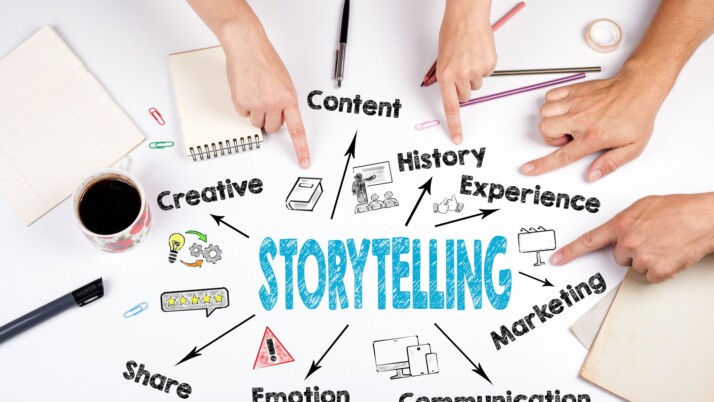A narrative is a sequence of connected events, real or imagined, that describe a story. They can be told orally or incorporated into descriptive essays, novels, short stories, or biographies. Understanding the types of narrative styles will help you tell your story uniquely.
This guide will look at the types of narratives and how to use each to tell a good story effectively.
What Is Narrative Style?
A narrative is writing that unites distinct events by concept, idea, or plot to tell a story. Narratives invariably involve telling a story through dialogue or descriptive text, either in prose or in the form of a dramatic piece. A narrative is a string of events that form a complete, continuous account that helps you tell your story. It is a written representation of a particular situation that reflects or conforms to an overarching set of values or goals.
The narrative style is a literary device that presents a story set in the past, present, or future. It tells the story about an individual, an institution, or an event. The narrative style of work plays a vital role in the reader’s emotions and embodies the style of exposition.
Types of Narrative Writing
Every writer is a different kind of narrative writer. The wide variety of descriptive essays, novels, and short stories that exist today is proof of a storyteller’s tendency to use narrative art. Narratives can be everything from personal musings to narratives of historical events and political reportage. Here are the common types of narratives.
1. Linear Narrative
Linear narratives follow a chronological order and relay the events of a story in the order in which they happened. It is a typical storytelling style that follows the traditional progression of a character’s beginning, middle, and end.
A linear narrative essentially features a story that immerses the reader into the protagonist’s daily life. This happens as the readers watch the events of the character’s life unfold in chronological order. The story can be told from any viewpoint, whether it’s the first-person narrative, second-person narrative, or third-person. Narrative linearity is displayed in David Mitchell’s Cloud Atlas andJane Austen’s Pride and Prejudice.
2. Non-linear Narrative
A non-linear narrative does not follow a chronological timeline of events. It may jump back and forth in time to pursue different characters or explore events out of sequence. This narrative type employs flashbacks and other literary devices to convey the story. For instance, telling the story of hunger, then recounting the story of the first meal.
Short stories or novellas can fracture the story’s timeline to emphasize the emotional mindset of a personal narrative or make connections between non-contemporary events. Non-linear narratives are used to build suspense and show stories with related themes unfolding in different places and times. Typical examples of non-linear narrative are Homer’s poem The Odyssey, and Richard Powers’ ‘The Overstory.’
3. Viewpoint Narrative
Viewpoint narrative is a type of narrative style that tells a story from the perspective of a particular character. Unlike a linear narrative, a viewpoint narrative does not have a specific arc or structure. It has a physically omniscient viewpoint whose primary focus is on the character’s view, not the events around the character. This style of narration usually involves first-person narration or third-person omniscient narration.
Vladamir Nabokov’s book Lolita features the first-person viewpoint of Humbert. A man who has been in a mental clinic multiple times and casts the whole story in an untrustworthy light.
4. Quest Narrative
A quest narrative is a story in which the protagonist is relentlessly working towards a goal. This goal becomes their all-consuming passion, and they have to face seemingly insurmountable obstacles while pursuing it. The object of their pursuit is far away, and they must travel a long way to find it.
Quest narrative was displayed in The Odyssey, where Odysseus returned home to his wife. Also, in Apocalypse Now, Captain Willard embarked on a journey through the jungles of Vietnam to find Colonial Kurtz.

To Wrap Up
Narrative story-telling is a popular literary form that demonstrates a sequence of actions, thoughts, and feelings that communicate events. There are different narrative styles, including linear, non-linear, quest, and viewpoint narratives. Understanding the types of narratives will increase your ability to connect to your audience with a story.
Explore All Descriptive Text Articles
Effective Writing Tips to Describe a Person
As with any piece of writing, it’s essential to paint a picture vividly and make your reader fully grasp your…
Best Words to Describe Your Personality
There are instances when you’ll be required to describe yourself. It can be for a job interview or when introducing…
30+ Interesting Words To Describe Beauty
Beauty is the quality of being physically or visually attractive. It is the aesthetic properties of an entity, a natural…
Interesting Adjectives to Describe Movies
You might need to give a review about a movie you just watched. While you can use a few phrases…
Interesting Personality Adjectives to Describe People
What words best describe you? Funny? Determined? Hardworking? These words are adjectives. Adjectives modify one’s personality. They’re an easy and…
The Most Creative Words to Describe Smell
When depicting smell, descriptive language can help the reader have a much more vivid experience. This article explores the best…
